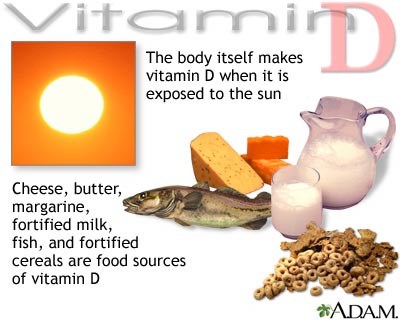Vitamin D is found in many dietary sources such as fish, eggs, fortified milk, and cod liver oil. The sun also contributes significantly to the daily production of vitamin D, and as little as 10 minutes of exposure is thought to be enough to prevent deficiencies. The term “vitamin D” refers to several different forms of this vitamin.
Two forms of Vitamin D are important in humans: ergocalciferol (vitamin D2) and cholecalciferol (vitamin D3). Vitamin D2 is synthesized by plants. Vitamin D3 is synthesized by humans in the skin when it is exposed to ultraviolet-B (UVB) rays from sunlight. Foods may be fortified with vitamin D2 or D3.
Vitamin D Needs and Deficiency

Recently, research also suggests vitamin D may provide protection from osteoporosis, hypertension (high blood pressure), cancer, and several autoimmune diseases.
Vitamin D helps your body absorb calcium, which your bones need to grow. A lack of vitamin D can lead to bone diseases such as osteoporosis or rickets. Vitamin D also has a role in your nerve, muscle, and immune systems.
Vitamin D is measured as Serum 25-Hydroxy vitamin D levels. A Serum Hydroxy vitamin D level of 10 ng/mL is low, a level of 15 ng/mL is adequate and a level of 200 ng/mL is potentially toxic
Rickets and osteomalacia are classic vitamin D deficiency diseases. In children, vitamin D deficiency causes rickets, which results in skeletal deformities. In adults, vitamin D deficiency can lead to osteomalacia, which results in muscular weakness in addition to weak bones.
Populations who may be at a high risk for vitamin D deficiencies include the elderly, obese individuals, exclusively breastfed infants, and those who have limited sun exposure. Also, individuals who have fat malabsorption syndromes (e.g., cystic fibrosis) or inflammatory bowel disease (e.g., Crohn’s disease) are at risk.
How to Get Vitamin D
You can get vitamin D in three ways: through your skin, from your diet, and from supplements. Your body forms Vitamin D naturally after exposure to sunlight. However, too much sun exposure can lead to skin aging and skin cancer. So many people try to get their vitamin D from other sources. You need to get anywhere between 200IU to 600IU of Vitamin D a day with the amount increasing as we age.
Vitamin D-rich foods include egg yolks, saltwater fish, and liver. Some other foods, like milk and cereal, often have added vitamin D.
You can also take vitamin D supplements. Check with your health care provider to see how much you should take. People who might need extra vitamin D include
- Seniors
- Breastfed infant
- People with dark skin
- People with certain conditions, such as liver diseases, cystic fibrosis and Crohn’s disease
- People who are obese or have had gastric bypass surgery
Foods high in Vitamin D
| Cod liver oil, 1 tablespoon | 1,360 |
| Salmon (sockeye), cooked, 3 ounces | 794 |
| Mackerel, cooked, 3 ounces | 388 |
| Tuna fish, canned in water, 3 ounces | 154 |
| Milk, nonfat, reduced fat, and whole | 115 |
| Orange juice fortified with vitamin D, 1 cup | 100 |
| Yogurt, fortified, 6 ounces | 80 |
| Margarine, fortified, 1 tablespoon | 60 |
| Sardines, canned in oil, drained, 2 sardines | 46 |
| Liver, beef, cooked, 3.5 ounces | 46 |
| Ready-to-eat cereal, fortified | 40 |
| Egg, 1 whole (vitamin D is found in yolk) | 25 |
| Cheese, Swiss, 1 ounce | 6 |
In a not very scientific survey I have personally found that many women are very deficient in Vitamin D. My wife and some of here friends have had to supplement a lot of Vitamin D just to try to catch up
The post Vitamin D Deficiency and Vitamin D Supplementation appeared first on Fitness Tips for Life.
http://bit.ly/2DRFEUr
No comments:
Post a Comment